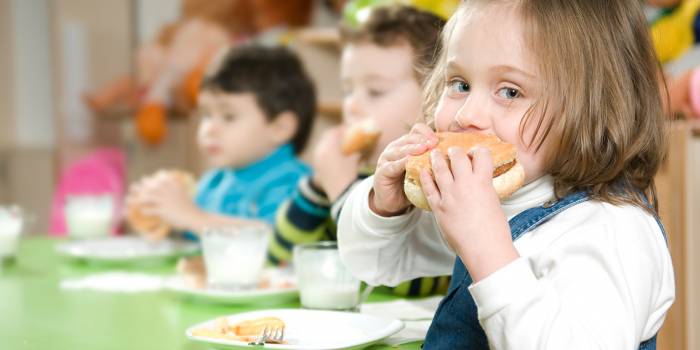“So really, the healthier school meals is a win for both children and for schools,” she said.
In many parts of the world, schools can barely afford classroom supplies, let alone daily meals, but nonprofit organizations or government programs often step in with feeding programs to provide free meals that include meat and veggies.
In other places, school cafeterias sell hot dishes, sandwiches and tiny milk boxes; children might pack a home-cooked meal; or they might go home for lunch.
A spotlight has been turned on what children eat for lunch in the wake of a rising obesity epidemic among the world’s youth. Obesity can increase the risk of chronic diseases including diabetes, heart disease, stroke, arthritis and even some cancers.
Globally, the number of overweight or obese children 5 and younger climbed from 32 million in 1990 to 41 million in 2016, according to the World Health Organization.
So what are they eating for lunch, and how could it affect their health? Here is a sampling of how children experience lunchtime around the world.
‘A really beautiful concept’
“I was fortunate enough to be able to go and actually see for myself a school lunch there, and one of the things that I thought was particularly nice about it was that the children serve each other,” Cohen said.
“They are able to sit in the classroom, in a more relaxed environment, to have the food, and one thing that really stood out to me was how often the children were willing to at least try a taste of the different foods on their trays — in part, out of respect to say thank you to the people who had spent all that time making that meal,” she said. “I thought that was a really beautiful concept.”
Outside school, however, household income is associated with food and nutrient intake among schoolchildren in Japan, according to a study published last year in the journal Public Health Nutrition.
The study involved 409 boys and 427 girls in the fifth grade across 19 schools in East Japan. The children, with the support of their parents, kept dietary records with photographs over a four-day period. Two of those days involved school lunch, and two did not. Meanwhile, the parents completed a questionnaire about their socioeconomic status.
“Our study confirmed an association between household income and the amount of foods and nutrients consumed by Japanese schoolchildren, and suggested that school lunches play a role in reducing disparities in the diets of children from households with various incomes,” the researchers wrote in the study.
In some countries, school lunch has been a way not only to reduce disparities but also to combat childhood hunger.
‘School feeding programs are ubiquitous’
Brazil has the world’s oldest school feeding program, providing daily meals to more than 43 million of the country’s children, according to the World Food Programme.
School feeding has been mandatory in primary and secondary schools in Brazil since 1955, and in 2009, policy was introduced to establish a 30% minimum quota of using organic agricultural products from local farmers in the program, according to the Food and Agriculture Organization of the United Nations.
“In Brazil, we have some limitations about processed food or food with sugar, salt, saturated fat in the composition,” said Marcela Veiros, a researcher in the department of nutrition at the Federal University of Santa Catarina in Brazil.
“We offer mainly fresh food prepared from scratch in schools by food handlers. Menus are developed and supervised by nutritionists from municipality or state governments. The federal government improved and supported local and family farmers in Brazil to produce food to be delivered to schools,” she said. “The recommendation also is to use local and typical products, in respect to cultural and food habits, and native environment.”
India has one of the world’s largest school meals projects. Through the Akshaya Patra Foundation, the program feeds more than 1.6 million children a free midday meal in government-aided and government schools across 12 states.
Across 69 countries, the humanitarian organization World Food Programme implemented or supported school meal programs in 2016. Through the program, school meals were provided to 16.4 million children, according to its website.
In Tunisia, some of the students receiving these meals are also employed as caterers, and in places like Egypt, Jordan and Lebanon, some are Syrian refugees, according to the World Food Programme.
In other parts of the world, however, school lunch is not as common.
A paper published last year in the journal Healthcare in Low-resource Settings assessed health services in primary schools in Nigeria’s Enugu East and found that lunch was given by only one private school. One public school had a free meal program, but it collapsed.
Most of the private schools in the paper attributed their lack of school lunches to costs and to the objection of parents who would rather prepare meals for their children.
Whether provided through a humanitarian or governmental program, about how much do school feeding programs cost?
A 2013 study published in the journal Food and Nutrition Bulletin found that school feeding programs cost about $173 per child per year, ranging from an average of $54 in low-income countries to an average of $693 in high-income countries.
The study also showed that the range of costs in low-income countries decreased between 2005 and 2008 by about 35%, suggesting that some cost-containment measures had been implemented during that time. The researchers took a close look at costs in both years.
The study involved data on 74 countries that came from multiple sources, including United Nations databases, the World Food Programme, government ministry reports and previously published studies.
“School feeding programs are ubiquitous in high-, middle-, and low-income countries,” the researchers wrote in the study.
“Moreover, many countries for which data are available do not seem to be seeking to cease providing food to their schoolchildren,” they wrote. “Many countries in fact appear to be seeking to expand the coverage of their programs and establish them as national programs mainstreamed into national policy.”
CNN
More about: schoollunch
















































